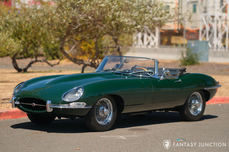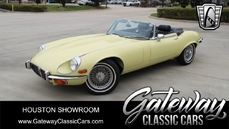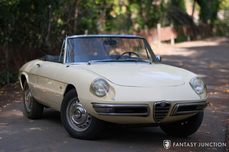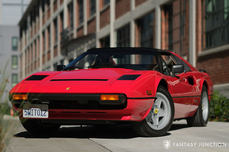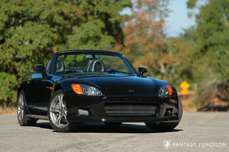Jaguar E-type 1970
Allgemeine Beschreibung :
1970 Jaguar XKE Series II Roadster
Chassis Number – 1R12172
Exterior Color – Regency Red
Interior Color – Tan leather
Engine – 4.2 Liter DOHC in-line six-cylinder engine
Transmission – 4-Speed manual
Current Miles – 73,073 miles (TMU)
General History
Beautiful body lines, unrivaled performance, and racing lineage combined at the dawn of the 1960s to make the Jaguar XKE an immediate sensation. With its beautiful design and affordable price, the E-Type grew to iconic status where it continues to be adored by collectors and enthusiasts worldwide. Independent front and rear suspension, disc brakes all around (inboard at the rear), and Jaguar’s legendary twin-cam inline six-cylinder engine were among the many performance features of the legendary XKE. Sales were brisk with continuous development growing in both American and European markets. In 1968, the Series II was launched which included open headlights, wraparound rear bumpers, larger taillights, and a larger grille with twin electric fans to aid in cooling.
Though initially developed to concurrently release with the original line up, the 2+2 model did not arrive in production until 1966. The added rear seating, while suitable for small passengers, created some packaging challenges to allow for the larger passenger compartment and taller roofline. While the proportions were unique to the 2+2 offering, by the late 60s the mechanical improvements across all models made for a very enjoyable car, capable of combining performance with stylish family transportation.
History of this Example
Like many Jaguars of this era, this example was driven recreationally and partially restored by prior owners. A generally sound example, this car benefited from residence for many years in southern Oregon. According to prior owner history, in the early 1980s, the car was purchased from an Ashland, OR repair shop on a tip from two strangers conversing while on a flight to Portland. Upon arriving at the repair shop, the new owner cured the outstanding bill and purchased the car. The car and several boxes arrived at the new owner’s home where it was gradually rebuilt as a long-term hobby project enjoyed by a local Oregon couple. Work performed on the car was done by a host of specialized vendors including paint applied most likely in the late 1980s along with various mechanical and cosmetic details as needed. Driving was limited to local events until the owners parked the car indoors and stored it with regular operation until 2010. The car was reportedly not driven when it was purchased and mechanically recommissioned by the next owner.
Under more recent ownership, this Jaguar has been mechanically freshened and gently recommissioned with attention to mechanical features. The engine was cleaned, carburetor needle valve and gaskets replaced for both carburetors, new fuel hoses installed, a secondary fuel filter installed, ignition system rewired, and a fresh set of spark plugs installed along with a new oil pressure sender. A new brake master cylinder and booster were installed, a new clutch slave cylinder installed, and the heater control valve repaired. The brake fluid reservoirs were rewired, and a battery hold down bracket installed. During the recommission the fuel was drained, crankcase oil and filter changed, and the hydraulic system flushed. The electrical system was comprehensively reviewed, electrical contacts cleaned, switch functions checked, lighting replaced as needed, and other electrical features tested for operation.
For the interior, the instruments were reviewed, the speedometer repaired, the tachometer lubricated and adjusted, heater control lever and choke mechanism replaced, the instrument voltage regulator replaced, and turn signal/hazard wiring repaired. The carpet was replaced, the seats were removed for seat track cleaning, and adjusted for smooth function. The convertible top mechanism was also serviced to ensure smooth operation.
Current Condition
Today this Jaguar presents as an attractive and honest example which benefits from older restoration work performed several years ago. Although the restoration work has aged the car still presents as a visually pleasant example. The paint is glossy and nicely done, though there are areas of light surface bubbling on the driver’s front fender, minor road chips, trunk lid chips, and light swirling in some areas of the finish. The front of the car benefits from the thinner profile chrome bumper and much of the chrome is in good condition despite minor cosmetic flaws, though very much in keeping with the overall driver-level presentation. The tan canvas top fits properly to the windshield and remains in nice visual condition, appearing to have had only minimal use. The chrome wire wheels are in excellent condition and correct for this series, shod with a set of Vredestein 205/70 SR15 radial tires. The lights and glass are in very good condition as well with nice presentation, again in keeping with the overall quality driver-level condition.
The interior is in excellent shape considering the older restoration. The leather seats retain clean surfaces and soft feel. The console and dashboard upholstery are very nice, and the carpet is clean and quite nice, having been more recently replaced. The steering wheel has the correct appearance and nicely finished aluminum spokes with a handsome center emblem. A late model Sony AM/FM cassette radio is installed. The instruments are in excellent visual condition although the tachometer and oil pressure gauge are currently not functional. The switches and controls are in very nice shape as well, once again contributing to the look and feel of a driver level sports car. Although the convertible top has not been used much and the exterior is in generally good condition, the inside top bow liner fabric seams have come unglued.
The engine compartment is generally clean and nicely detailed. The engine itself is quite tidy and appears to be visually consistent with original specifications. The suspension A-arms show some surface age and the painted engine areas also have aged over time, but here too in keeping with the overall presentation. The trunk has been properly finished with matching tan material, housing a full-size wire wheel. The undercarriage reveals a clean and tidy car that has seen road use, jack point repairs, and overspray, but still maintains a very presentable level of finish, including a few painted and raw metal surfaces, cosmetically touched up in various places.
One of the added benefits of the later Series II cars is the improved driver ergonomics which accommodates larger drivers and contributes greatly to the driving experience. The joys of open two-seater roadster configuration are further enhanced with the E-Type long hood and short deck. Seating position is very well balanced and driver ergonomics well suited to touring with comfort and luggage space that encourages weekend getaways. General operational features are consistent with the presentation including shifting and engine power, braking, and steering which function consistent with cars of this age.
This is an excellent opportunity to acquire an honest, driver-level E-Type Roadster ready to enjoy, refine over time, and appreciate as one of the best-looking sports cars ever created. Series II examples represent outstanding value compared to Series I roadsters. For anyone seeking a Series II E-Type, this example represents the right balance of beauty and usability, readily prepared for your ongoing motoring enjoyment.
1970 Jaguar E-type is listed zu verkaufen on ClassicDigest in California by Fantasy Junction for Preis nicht verfügbar.
Fakten der Auto
Karosserietyp : Auto Marke : Jaguar Modell : E-type Hubraum : 4.2 Modelljahr : 1970 Karosstyp : Convertible Farbe : Rot Farbtyp : Normal färg Lage : Emeryville Fahrzeug Anmeldung : Normal
Preis nicht verfügbar
Angaben Zum Verkäufer
Fantasy Junction
Fantasy Junction
+1 510 653 7555
Fantasy Junction
+1 510 653 7555
People who viewed this Jaguar E-type also viewed similar Jaguar listed at ClassicDigest
Other cars listed for sale by this dealer
über Jaguar
Ah, die Geschichte von Jaguar, von seinen Anfängen als SS Cars Ltd. bis hin zum Höhepunkt mit dem D-Typ und der Straßenversion des ikonischen E-Typs. An dieser Erzählung haftet etwas zutiefst Britisches, und ich werde sie erzählen, wie es ein britischer Journalist tun würde.Die Anfänge:
Unsere Reise in die Welt von Jaguar beginnt in den 1930er Jahren, als ein Unternehmen namens SS Cars Ltd. auftauchte. Trotz des unglücklichen Zufalls ihrer Initialen, die mit den aufkommenden politischen Spannungen in Europa zusammenfielen, begannen sie, stilvolle und leistungsorientierte Autos herzustellen. Der SS 100, der 1936 eingeführt wurde, war ein Symbol für Eleganz und Geschwindigkeit und legte den Grundstein für das, was Jaguar werden sollte.
Die Geburt von Jaguar:
Als der Schatten des Zweiten Weltkriegs näher rückte, entschied sich SS Cars Ltd. klugerweise, sich von den SS-Initialen zu distanzieren. So wurden sie 1945 offiziell zu Jaguar Cars Ltd., ein Name, der bald für britischen Luxus und Leistung stehen würde.
Die XK-Serie:
Die Nachkriegszeit von Jaguar brachte uns den XK 120, eine wahre Sensation im Jahr 1948. Mit seinem schlanken Design und einem leistungsstarken 3,4-Liter-Sechszylindermotor wurde er zum schnellsten Serienauto der Welt. Der XK 120 war die Blaupause für das, was kommen würde - Jaguars, die Stil mit Geschwindigkeit auf einzigartig britische Weise verbanden.
Die Dominanz des D-Typs:
Dann kam der D-Typ, eine wahre Rennlegende. 1954 eingeführt, gewann er in den 1950er Jahren dreimal Le Mans und zeigte die technische Kompetenz von Jaguar. Mit seiner innovativen Monocoque-Konstruktion und der ikonischen Finne hinten war der D-Typ der Höhepunkt von Jaguars Motorsporterfolgen.
Das Auftauchen des E-Typs:
Aber der wahre Wendepunkt kam 1961 mit der Einführung des E-Typs, oft von Enzo Ferrari als "das schönste Auto, das je gebaut wurde" bezeichnet. Seine lange Motorhaube, die geschwungene Karosserie und ein 3,8-Liter-Motor, der atemberaubende Leistung lieferte, machten ihn sofort zu einem Klassiker. Der E-Typ war nicht nur ein Auto; er war ein Kunstwerk auf Rädern und konnte auf der Straße 150 Meilen pro Stunde erreichen.
Straßen- und Rennsporterfolge:
Die Schönheit des E-Typs wurde durch seine Leistung auf der Rennstrecke unterstrichen. Die leichten E-Typen waren bei verschiedenen Rennveranstaltungen besonders erfolgreich und festigten den Ruf von Jaguar als eine Kraft, mit der man im Motorsport rechnen musste.
Das Zeitalter der Raffinesse:
Je tiefer wir in die Geschichte von Jaguar eintauchen, desto mehr erkennen wir, dass die 1950er und 1960er Jahre ein Zeitalter der Raffinesse und Expansion waren. Neben dem großartigen D-Typ und dem ikonischen Aufstieg des E-Typs führte Jaguar Modelle ein, die seinen Ruf für Luxus und Leistung weiter festigten.
Der MK2:
Ende der 1950er Jahre stellte Jaguar den MK2 vor, eine Sportlimousine, die Eleganz mit Leistung vereinte. Diese elegante viertürige Limousine war sowohl bei Bankräubern als auch bei der Polizei aufgrund ihrer außergewöhnlichen Geschwindigkeit und Handhabung beliebt. Der MK2 war ein Symbol für Jaguars Fähigkeit, Raffinesse mit Leistung zu verbinden und hatte auch eine erfolgreiche Rennkarriere.
Der XJ6:
Springen wir ins Jahr 1968, als Jaguar ein Auto auf den Markt brachte, das Jahrzehnte lang Luxuslimousinen definieren würde - den XJ6. Es war ein Meisterwerk der Ingenieurkunst und des Designs, mit einem sanften Reihensechszylindermotor, unabhängiger Hinterachse und einem geräumigen, wunderschön ausgestatteten Innenraum. Der XJ6 war ein Symbol britischer Eleganz und bot eine so sanfte Fahrt, dass es schien, als würde er förmlich über die Straße gleiten. Er wurde zum Flaggschiffmodell für Jaguar und setzte den Maßstab für Luxuslimousinen und zeigte ein Maß an Raffinesse, das die Konkurrenz staunen ließ.
Die Verschmelzung von Klassik und Moderne:
Während der MK2 und der XJ6 die Evolution der Limousinen von Jaguar repräsentierten, bewahrten sie das Engagement der Marke für Leistung und Luxus. Diese Autos gehörten nicht nur auf die Rennstrecke; sie fühlten sich genauso wohl auf den Prachtstraßen wie auf einer entspannten Fahrt durch die englische Landschaft.
Die Herausforderungen des Wandels:
Dennoch sah sich Jaguar mit dem Eintritt der 1970er Jahre, wie viele britische Automobilhersteller, finanziellen Herausforderungen und Veränderungen in der Eigentümerschaft gegenüber. Die Ära von British Leyland brachte sowohl Chancen als auch Schwierigkeiten mit sich, während die Marke durch verschiedene Fusionen und Übergänge navigierte.
Das Erbe des MK2 und des XJ6, zusammen mit dem D-Typ und dem E-Typ, definiert Jaguar weiterhin als einen Hersteller, der zeitlose Eleganz mit einer Leistungsstärke vereint. Diese klassischen Modelle, ob sie über kurvige Straßen gefahren oder als Sammlerschätze geparkt werden, dienen als Zeugnis für die anhaltende Präsenz von Jaguar in der Welt der automobilen Exzellenz.
Die Jaguar-Geschichte, von ihren Anfängen als SS Cars Ltd. bis zur Schaffung von Automobilikonen wie dem E-Typ, dem MK2 und dem XJ6, ist eine Reise, die das Wesen des britischen Automobilbaus widerspiegelt - eine Mischung aus Luxus, Leistung und Stil, die nach wie vor Enthusiasten und Kenner gleichermaßen fasziniert.

















